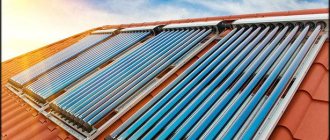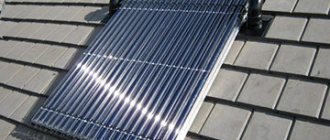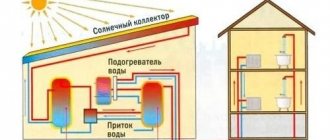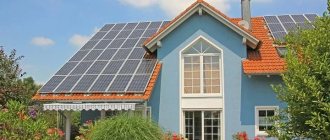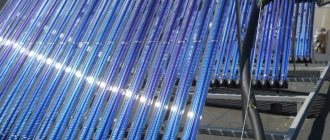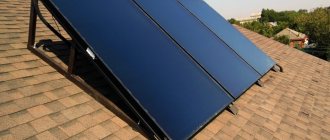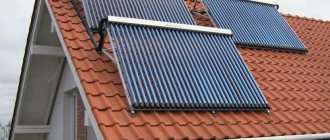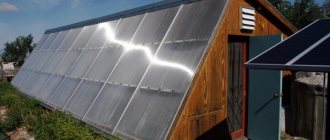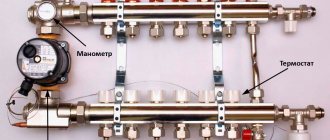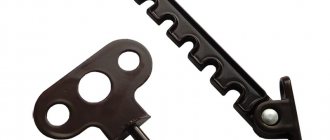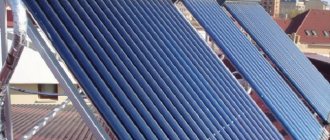Greetings, comrades! How beneficial do you think a solar collector is for heating? I will introduce you to the design and types of collectors, and then I will perform a simple calculation of the efficiency of solar heating, which will allow you to give it an unambiguous assessment. So, let's go.
Vacuum heating collectors and solar panels on the roof of a private house.
Efficiency
Solar collectors, or solar systems, can operate all year round without interruption.
Even in cloudy conditions, more than half of the radiation reaches the earth's surface. In addition, their operation is absolutely safe for humans and the environment. Any helio kit is easy to maintain, looks aesthetically pleasing, and improves the appearance of a private home. The advantages of the devices also include:
- autonomy of hot water supply in winter, summer, during interruptions and repair work;
- service life up to 30 years, payback with benefits from heating costs in 3-5 years;
- no tariffs, monthly calculations are independent of increases in electricity prices;
- possibility of simultaneous use for heating swimming pools, greenhouses, utility rooms;
- easy integration into an existing heating kit;
- absence of dirt, waste;
- reducing the total load on the electrical and heating networks of the house;
- optimization for your own needs.
The negative aspects of using solar collectors are not so numerous:
- high cost of initial purchase and installation. Depending on the manufacturer, scale and configuration, the entire solar system can cost up to 10 thousand dollars. Even simpler models cost a large sum, which must be paid at a time;
- The efficiency of collectors can be influenced not only by climatic conditions, but also by landscape features, roof shape, typical daylight hours and other factors. The payback period depends on such indicators.
Passive circulation within the solar collector will result in lower derivative efficiency. With forced control, water and energy are spent more productively. The second option requires more complicated maintenance, but is more suitable for middle-class living conditions. For southern regions, the introduction of a solar system often reduces electricity bills by half.
The efficiency of the solar collector reaches 95%. Regions with harsh climates show a lower indicator, but also justify their use. To calculate the annual efficiency of a collector, you need to multiply the amount of insolation in the region for the year (there are special tables), the absorption area of the system and its efficiency. The daily benefit is calculated in the same way, but taking into account the corresponding (daily) insolation indicator.
A story about a collector in winter
Review of 5 popular models and prices for sets
The most popular are flat-plate collectors. The reason for this lies in the relatively low prices, although such systems also cost considerable sums. Let's look at some options.
Small system from
Designed for heating and heating small (up to 50 m2) houses , or for hot water supply to larger premises. Consists of 1 solar collector, 250 liter tank (tank volume is selected with a reserve in case of night time or bad weather). Thermal power is 2 kW , the price of the set is 160 thousand rubles.
Solar water heater "Spectrum"
The “Spectrum” solar water heater can be purchased separately, which allows you to create the missing components of the system yourself and significantly save money. The price of one Spectr 850-S collector is 24,000 rubles. Output power is 1-1.6 kW , depending on weather conditions.
Set “Winter-500”
The “Winter-500” kit consists of a 500-liter tank, one manifold for 30 vacuum tubes, and a support frame for roof mounting. The price of the kit will be 330,000-430,000 rubles , depending on the place of purchase.
Vacuum solar collector SVK-40
The vacuum solar collector SVK-40 will cost 90,000 rubles . It is designed for a two-circuit system with forced circulation and is capable of providing heat and hot water to a medium-sized house . Additional equipment can be purchased or made independently, saving money.
Solar vacuum collector TZ58-1800-10R1
The solar vacuum collector TZ58-1800-10R1 consists of a 100-liter tank, a thermal controller, and a pumping station. The kit is capable of efficiently generating thermal energy even at -25°, with an average output of about 10 kW/day . The price of the set is about 90,000 rubles.
The examples provided have been deliberately selected from a variety of types and packages to provide as much information as possible about the cost and composition of the equipment offered. There are larger systems, you can find very small collectors, but on average devices of this level are used.
Advantages and disadvantages
Like any technical device, the solar collector has its pros and cons, both in terms of the possibility of use and operation, and in terms of other parameters and indicators. Depending on the design of the device, the pros and cons vary, so it is necessary to consider them separately from each other.
Flat solar collectors.
Advantages of use:
- When used in southern regions with warm climates, the best indicators in the price-performance ratio;
- During precipitation in the form of snow, they have the ability to self-clean;
- They have high efficiency when used in summer;
- Relatively low cost in comparison with analogues of other designs.
The disadvantages are:
- Significant heat losses caused by the design features of the device;
- Low efficiency when working in the autumn-spring period;
- Difficulty in transporting and installing finished products;
- The high windage of the structure creates a risk of damage to its elements during operation;
- Difficulty and labor-intensive repair work.
Vacuum solar collectors.
Advantages of use:
- When used in regions with cold and temperate climates, the best indicators in the price-performance ratio;
- Insignificant heat losses during operation, in comparison with analogues of other designs;
- Ability to work at low and negative ambient temperatures;
- Ability to work in low solar activity in the morning and evening hours, as well as in the absence of direct sunlight (cloudy weather);
- Easy and convenient installation, transportability of structures;
- Reliability during operation.
The disadvantages are:
- Relatively high cost;
- Strict installation requirements that determine the location of the collector in space in relation to the surface of the earth.
Efficient use of solar energy
The most obvious advantage of using solar energy is its universal availability. In fact, even in the gloomiest and cloudiest weather, solar energy can be collected and used.
The second advantage is zero emissions. In fact, it is the most environmentally friendly and natural form of energy. Solar panels and collectors do not produce noise. In most cases, they are installed on the roofs of buildings, without occupying the usable area of a suburban area.
The efficiency of solar heating in our latitudes is quite low, which is explained by the insufficient number of sunny days for regular operation of the system (+)
The disadvantages associated with using solar energy are the variability of illumination. At night there is nothing to collect, the situation is aggravated by the fact that the peak of the heating season occurs during the shortest daylight hours of the year. It is necessary to monitor the optical cleanliness of the panels; slight contamination sharply reduces the efficiency.
In addition, it cannot be said that operating a solar energy system is completely free; there are constant costs for equipment depreciation, operation of the circulation pump and control electronics.
A significant disadvantage of heating based on the use of solar collectors is the lack of ability to accumulate thermal energy. Only the expansion tank (+) is included in the circuit
Open solar collectors
An open solar collector is a system of tubes, unprotected from external influences, through which coolant heated directly by the sun circulates.
Water, gas, air, and antifreeze are used as coolants. The tubes are either fixed to the supporting panel in the form of a coil, or connected in parallel rows to the outlet pipe.
Open solar collectors are not able to cope with the heating of a private home. Due to the lack of insulation, the coolant cools quickly. They are used in the summer mainly to heat water in showers or swimming pools.
Open collectors usually do not have any insulation. The design is very simple, therefore it has a low cost and is often made independently.
Due to the lack of insulation, they practically do not store the energy received from the sun and are characterized by low efficiency. They are used mainly in the summer to heat water in swimming pools or summer showers.
Installed in sunny and warm regions, with small differences in temperature of the ambient air and heated water. They work well only in sunny, windless weather.
The simplest solar collector with a heat sink made from a coil of polymer pipes will provide the supply of heated water to the dacha for irrigation and domestic needs
Tubular collector varieties
Tubular solar collectors are assembled from individual tubes through which water, gas or steam flows. This is one of the types of open solar systems. However, the coolant is already much better protected from external negativity. Especially in vacuum installations, designed on the principle of thermoses.
Each tube is connected to the system separately, parallel to each other. If one tube fails, it is easy to replace it with a new one. The entire structure can be assembled directly on the roof of the building, which greatly simplifies installation.
The tubular collector has a modular structure. The main element is a vacuum tube; the number of tubes varies from 18 to 30, which allows you to accurately select the power of the system
A significant advantage of tubular solar collectors is the cylindrical shape of the main elements, thanks to which solar radiation is captured all day long without the use of expensive systems for tracking the movement of the luminary.
A special multilayer coating creates a kind of optical trap for sunlight. The diagram partially shows the outer wall of the vacuum flask reflecting rays onto the walls of the inner flask (+)
Based on the design of the tubes, feather and coaxial solar collectors are distinguished.
The coaxial tube is a Diaur vessel or a familiar thermos. Made from two flasks between which air is evacuated. A highly selective coating is applied to the inner surface of the inner bulb, effectively absorbing solar energy.
With a cylindrical tube, the sun's rays always fall perpendicular to the surface
Thermal energy from the internal selective layer is transferred to a heat pipe or internal heat exchanger made of aluminum plates. At this stage, unwanted heat loss occurs.
The feather tube is a glass cylinder with a feather absorber inserted inside.
The system gets its name from the feather absorber, which tightly wraps around a thermal channel made of heat-conducting metal.
For good thermal insulation, the air has been evacuated from the tube. Heat transfer from the absorber occurs without loss, so the efficiency of feather tubes is higher.
According to the method of heat transfer, there are two systems: direct-flow and with a heat pipe. Thermal tube is a sealed container with an easily evaporating liquid.
Since the easily evaporating liquid naturally flows to the bottom of the heat tube, the minimum inclination angle is 20° C
Inside the heat tube there is an easily evaporating liquid that receives heat from the inner wall of the flask or from the feather absorber. Under the influence of temperature, the liquid boils and rises in the form of steam. After the heat is transferred to the heating or hot water supply coolant, the steam condenses into liquid and flows down.
Water is often used as an easily evaporating liquid at low pressure. A once-through system uses a U-shaped tube through which water or heating fluid circulates.
One half of the U-shaped tube is intended for cold coolant, the second removes the heated one. When heated, the coolant expands and enters the storage tank, providing natural circulation. As with heat tube systems, the minimum angle of inclination must be at least 20⁰.
With a direct-flow connection, the pressure in the system cannot be high, since there is a technical vacuum inside the flask
Direct-flow systems are more efficient because they immediately heat the coolant. If solar collector systems are planned to be used all year round, then special antifreeze is pumped into them.
The use of tubular solar collectors has a number of advantages and disadvantages. The design of a tubular solar collector consists of identical elements that are relatively easy to replace.
Advantages:
- low heat loss;
- ability to work at temperatures down to -30⁰С;
- efficient performance throughout daylight hours;
- good performance in areas with temperate and cold climates;
- low windage, justified by the ability of tubular systems to pass air masses through themselves;
- possibility of producing high temperature coolant.
Structurally, the tubular structure has a limited aperture surface.
It has the following disadvantages:
- not capable of self-cleaning from snow, ice, frost;
- high price.
Despite the initial high cost, tubular collectors pay for themselves faster. They have a long service life.
Tubular collectors are open-type solar systems and are therefore not suitable for year-round use in heating systems (+)
Flat closed systems
A flat-plate collector consists of an aluminum frame, a special absorbent layer - an absorber, a transparent coating, a pipeline and insulation.
Blackened sheet copper is used as an absorber, which has ideal thermal conductivity for creating solar systems. When solar energy is absorbed by an absorber, the solar energy it receives is transferred to a coolant circulating through a tube system adjacent to the absorber.
On the outside, the closed panel is protected by a transparent coating. It is made of shockproof tempered glass with a transmission band of 0.4-1.8 microns. This range accounts for the maximum solar radiation. Shockproof glass provides good protection against hail. On the back side the entire panel is reliably insulated.
Flat-plate solar collectors are characterized by maximum performance and simple design. Their efficiency is increased due to the use of an absorber. They are able to capture diffuse and direct solar radiation
The list of advantages of closed flat panels includes:
- simplicity of design;
- good performance in regions with warm climates;
- the ability to install at any angle with devices for changing the angle of inclination;
- the ability to self-clean from snow and frost;
- low price.
Flat-plate solar collectors are especially advantageous if their use is planned at the design stage. The service life of quality products is 50 years.
The disadvantages include:
- high heat loss;
- heavy weight;
- high windage when the panels are positioned at an angle to the horizontal;
- performance limitations when temperature changes exceed 40°C.
The scope of application of closed collectors is much wider than that of open-type solar systems. In summer they are able to fully satisfy the need for hot water. On cool days, when utilities do not include them in the heating period, they can work instead of gas and electric heaters.
For those wishing to make a solar collector with their own hands for a heating device in their dacha, we suggest that you familiarize yourself with practice-tested diagrams and step-by-step assembly instructions.
Solar collector: types and subtypes of coolants
Depending on the temperature the collector plates can reach, they can be divided into the following types:
- Low temperature manifold;
- Medium temperature collector;
- High temperature collector.
A low-temperature solar collector will not be able to provide high-power energy. It will be able to heat water no warmer than 500 C.
Medium-temperature collectors can heat water up to 850-900 C. Such solar collectors are most optimal for heating a home and premises.
And high-temperature collectors are in great demand in industrial enterprises and large plants, so it is simply not possible to make them on your own.
Type of solar collector
All integrated solar energy carriers are divided into:
- Flat solar collectors;
- Air manifolds;
- Liquid energy carriers;
- Storage integrated solar collectors.
Thermosyphon solar coolant
Storage integrated solar collectors are also called thermosyphon collectors. Its main purpose is not only to heat water, but also to maintain the desired temperature for a certain time. These collectors do not have pumps, so they are much cheaper than other varieties.
The thermosyphon solar collector is manufactured in the form of a structure with one tank, which is filled with water and placed in a heat-insulating box. On top of the tank there is a glass cover, through which solar radiation passes through the glass and heats the water.
The only drawback of a solar collector is that it is unlikely to be used to its full potential in winter.
Flat coolant
Scheme of heating water in a boiler using a solar collector
A flat-plate solar collector looks like a regular flat metal box, inside of which there is a black plate through which solar energy passes.
The glass cover of the box accumulates solar radiation. Since glass has a low iron content, all the accumulated energy is transferred to the plate.
The flat-plate collector box is thermally insulated, and the black plate is thermally sensing, so heat is released from this design. And since the efficiency of the plate is no more than 10-15%, it is additionally coated with an amorphous semiconductor.
Flat energy carriers are designed for heating water in saunas, swimming pools, as well as for heating living rooms and other domestic needs.
Liquid solar collector
A liquid solar collector can be either glazed or unglazed. And also with a closed or open heat exchange system. But they are all united by the principle of operation of the coolant, which is based on liquid.
Air coolant
Scheme of drying grain using a solar collector
An air solar collector vaguely resembles the operation of a liquid collector. But it takes much less money to install and purchase it. In addition, air coolants do not freeze at negative air temperatures and do not leak.
Airborne solar collectors are good for drying agricultural products.
Concentrate
In addition to all the above types and subtypes of solar collectors, concentrators are also distinguished. The main distinguishing feature of concentrates from collectors is the concentration of solar radiation. This seems possible due to the mirror surface of the structure, thanks to which the sun's rays are directed to the absorbers.
The most significant disadvantage of this type of collector is the inability to function normally on bad weather days.
That is, concentrates are only suitable for work in countries where the climate is constantly hot.
Solar oven and distiller
And the last type of solar collectors can be considered furnaces powered by solar radiation and distillers. The operating principle of distillers is to evaporate water. Thus, they not only provide heat energy, but also purify water. Solar ovens also work using the same algorithm.
Methods for connecting to the heating system
Since solar-powered devices cannot provide a stable, round-the-clock energy supply, a system that is resilient to these shortcomings is needed.
For central Russia, solar devices cannot guarantee a stable flow of energy, so they are used as an additional system. Integration into an existing heating and hot water system is different for a solar collector and a solar battery.
Scheme with water collector
Depending on the purpose of using the heat collector, different connection systems are used. There may be several options:
- Summer option for hot water supply
- Winter option for heating and hot water supply
The summer option is the simplest and can even be done without a circulation pump, using the natural circulation of water.
The water is heated in the solar collector and, due to thermal expansion, enters the storage tank or boiler. In this case, natural circulation occurs: cold water is sucked out of the tank instead of hot water.
In winter, at subzero temperatures, direct heating of water is not possible. Special antifreeze circulates through a closed circuit, ensuring heat transfer from the collector to the heat exchanger in the tank
Like any system based on natural circulation, it does not work very efficiently, requiring compliance with the necessary slopes. In addition, the storage tank must be higher than the solar collector. In order for the water to remain hot for as long as possible, the tank must be thoroughly insulated.
If you really want to achieve the most efficient operation of the solar collector, the connection diagram will become more complicated.
To prevent the collector from turning into a cooling radiator at night, it is necessary to stop the water circulation forcibly
Non-freezing coolant circulates through the solar collector system. Forced circulation is provided by a pump controlled by a controller.
The controller controls the operation of the circulation pump based on the readings of at least two temperature sensors. The first sensor measures the temperature in the storage tank, the second - on the hot coolant supply pipe of the solar collector.
As soon as the temperature in the tank exceeds the temperature of the coolant, the controller in the collector turns off the circulation pump, stopping the circulation of coolant through the system. In turn, when the temperature in the storage tank drops below the set value, the heating boiler turns on.
Systems with vacuum tubes have become a new word and an effective alternative to solar collectors with coolant, the operating principle and design of which we suggest familiarizing yourself with.
Scheme with solar battery
It would be tempting to apply a similar scheme for connecting a solar battery to the electrical grid, as is implemented in the case of a solar collector, accumulating the energy received during the day. Unfortunately, for the power supply system of a private home, it is very expensive to create a battery pack of sufficient capacity. Therefore, the connection diagram looks like this.
When the power of the electric current from the solar battery decreases, the ATS unit (automatic switching on of a reserve) ensures the connection of consumers to the general power grid
From the solar panels, the charge is supplied to the charge controller, which performs several functions: ensures constant recharging of the batteries and stabilizes the voltage. Next, the electric current is supplied to the inverter, where 12V or 24V direct current is converted into single-phase alternating current 220V.
Alas, our electrical networks are not suitable for receiving energy; they can only work in one direction from source to consumer. For this reason, you will not be able to sell the extracted electricity or at least make the meter spin in the opposite direction.
The use of solar panels is advantageous in that they provide a more versatile type of energy, but at the same time they cannot compare in efficiency with solar collectors. However, the latter do not have the ability to store energy, unlike solar photovoltaic batteries.
Image gallery
Photo from
Solar power plants for home heating
The process of installing solar panels on the roof
Self-installation of the device on the garage roof
Homemade electrical appliance for solar heating
You will find everything about the options for organizing heating of a private house using solar panels in this article.
Structural drawings
Let's get started
Before building a solar collector, it is necessary to make the appropriate calculations and determine how much energy it should produce. But you shouldn’t expect high efficiency from a homemade installation. Having determined that there will be enough of it, you can begin.
The work can be divided into several main stages:
- Make a box
- Make a radiator or heat exchanger
- Make a front camera and storage device
- Assemble the collector
To make a box for a solar collector with your own hands, you should prepare an edged board 25-35 mm thick and 100-130 mm wide. Its bottom should be made of textolite, equipped with ribs. It should also be well insulated using polystyrene foam (but preference is given to mineral wool), covered with a galvanized sheet.
4 more effective ways to alternatively heat your home
Which you can learn about in our next article.
Having prepared the box, it’s time to make the heat exchanger. You should follow the instructions:
- It is necessary to prepare 15 thin-walled metal tubes 160 cm long and two inch pipes 70 cm long
- In both thickened tubes, holes are drilled with the diameter of the smaller tubes into which they will be installed. In this case, you need to ensure that they are coaxial on one side, the maximum step between them is 4.5 cm
- The next stage is that all the tubes need to be assembled into a single structure and welded securely
- The heat exchanger is mounted on a galvanized sheet (previously attached to the box) and fixed with steel clamps (metal clamps can be made)
- It is recommended to paint the bottom of the box in a dark color (for example, black) - it will better absorb solar heat, but to reduce heat loss, the external elements are painted white
- To complete the installation of the collector, it is necessary to install a cover glass near the walls, while not forgetting about reliable sealing of the joints
- A distance of 10-12 mm is left between the tubes and the glass
All that remains is to build a storage tank for the solar collector. Its role can be played by a sealed container, the volume of which varies about 150-400 l
. If you cannot find one such barrel, you can weld several small ones together.
Like the collector, the storage tank is thoroughly insulated from heat loss. All that remains is to make a fore-chamber - a small vessel with a volume of 35-40 liters. It must be equipped with a water-falling device (a swivel valve).
The most responsible and important stage remains - to assemble the collector together. You can do it this way:
- First you need to install the front camera and storage. It is necessary to ensure that the liquid level in the latter is 0.8 m lower than in the front chamber. Since a lot of water can accumulate in such devices, it is necessary to think about how they will be reliably shut off
- The collector is placed on the roof of the house. Based on practice, it is recommended to do this on the south side, tilting the installation at an angle of 35-40 degrees to the horizontal
- But you need to take into account that the distance between the storage tank and the heat exchanger should not exceed 0.5-0.7 m, otherwise the losses will be too significant
- At the end, the following sequence should be obtained: the front camera must be located above the drive, the latter - above the collector
The most important stage is coming - it is necessary to connect all the components together and connect the water supply network to the finished system. To do this, you will need to visit a plumbing store and purchase the necessary fittings, adapters, sockets and other shut-off valves. It is recommended to connect high-pressure sections with a pipe with a diameter of 0.5 inches, low-pressure sections with a diameter of 1 inch.
Commissioning is carried out as follows:
- The unit is filled with water through the bottom drainage hole
- The anterior chamber is connected and the fluid levels are adjusted
- It is necessary to walk along the system and check that there are no leaks
- Everything is ready for everyday use
Do-it-yourself assembly of the unit
The process of assembling a vacuum manifold begins with the manufacture of a support frame for the working elements. It is installed immediately in the place allocated for the unit.
The size and dimensions of the frame depend entirely on the model that is planned to be made, and are usually prescribed in the instructions found among the accompanying documents for the components.
The finished frame for the collector is fixed to the roof so that it occupies a clear position and does not swing. If the roof of the building is slate, use sheathing beams and large-caliber thick screws. For other roofing materials, conventional anchors are used
I additionally fix the places where the frame meets the roof surface with sealant so that in the future water does not enter the house through the holes. Then the storage tank is delivered to the installation site and secured with screws to the top of the frame.
At the next stage, the heating element, temperature sensor and automated air outlet are assembled. All auxiliary components and related parts are placed on the included softening pads. To attach the temperature sensor, use a socket wrench.
Next, the supply of water supply communications is arranged. For this purpose, pipes are taken from any material that is resistant to low temperatures and can withstand up to 95°C. Polypropylene pipes and fittings have proven themselves well.
Polypropylene pipes are ideal for connecting the solar collector to the residential plumbing system. The reinforcement has good physical properties and operational endurance, serves reliably for many years and is easily replaced in case of cracks or tears.
Having connected the water supply, the storage tank is filled with water and tested for leaks. If leaks are found somewhere within 3-4 hours, they are repaired.
At the end, heating elements are installed. To do this, the copper tube is wrapped in aluminum sheet and placed in a glass vacuum tube. From below, a fixing cup and a boot made of durable, flexible rubber are placed on the flask.
The upper copper tip of the tube is pushed all the way into the brass condenser. Viscous thermal contact grease is not removed from the pipes. Snap the locking mechanism onto the bracket and mount all remaining glass tubes using the same principle.
Tubular solar collectors require regular maintenance and mandatory cleaning, especially during periods of active snowfall. If you follow these simple rules, they will work for a long time and maintain a high level of efficiency throughout their entire service life.
A mounting block is placed on the structure, a 220-volt power supply is supplied to it, and three auxiliary units are connected to the system - a heating element, an air vent and a temperature sensor.
The last thing to connect is a controller designed to correctly control the complex. The desired operating parameters are entered into the controller menu and the system starts in standard mode.
Step-by-step instructions for constructing a solar collector are given in this article.
Device and types
Conventionally, these systems can be classified into two types
:
- liquid (which we talk about in this material);
- air solar collectors, which use heated air rather than liquid.
They are also divided according to efficiency, because they provide different heat transfer. It depends on the materials used to make the battery and its area. The optimal location for the absorber is the roof
:
- receives the maximum amount of sunlight,
- has a large area
- The battery installed on the roof does not take up any useful space and does not interfere with anyone.
Air solar collector
The design of the solar collector can be of several types, the main
:
- vacuum heating manifold, which has the most complex design. Vacuum solar collectors are excellent for heating rooms, heating water at any time of the year, they will completely provide a small house or cottage;
- A flat solar collector can be liquid or vacuum. This is the most common type because it is quite easy to install, yet it is efficient and can provide the house with the necessary amount of heat for heating the premises, and water for household needs;
- thermosiphon - glass or metal tubes are used as an absorber;
- tubular - the simplest type that can be made for a summer residence; it is quite primitive and not suitable for use in winter.
We are interested in a design that ensures the availability of hot water and heating in the house at any time of the year; we will focus on two optimal options, consider the design of a vacuum solar collector and a flat one.
Flat-plate collector
This is the most common type of collector that you can make yourself. Well suited for use in the warm season for heating water; in winter the efficiency decreases.
The design feature is as follows
:
- the body has a flat rectangular or square shape, made of metal or other material with a high thermal conductivity, coated with black paint;
- inside there is a plate in which a coil made of a copper tube of small cross-section is laid;
- coolant circulates through the tubes: water, propylene glycol, antifreeze, and other suitable liquids;
- also, thermal insulation material is placed inside the housing, which minimizes heat loss;
- When assembling a collector of this type, you need to stock up on a sheet of polycarbonate or glass, which will serve as a cover and perform two functions: prevent the penetration of debris and precipitation, and enhance heating.
Component of a flat-plate solar collector
Vacuum manifold
For water heating, vacuum-type solar collectors can be used. Thanks to their design features, they are more powerful: they are able to generate thermal energy, which is enough to heat water and heat rooms.
Design Features
:
- Tubes that are placed in flasks with the air pumped out allow to minimize losses;
- the tubes are covered on top with an absorption material that absorbs light energy, and inside they are filled with antifreeze (refrigerant);
- the ends of the tubes are connected to a pipe through which the coolant passes;
- when heated, the antifreeze boils and turns into steam, which, in turn, rises and heats the coolant;
- This design has a drawback: if at least one tube fails, repair becomes quite problematic, since they are connected in series. All the “internals” will have to be replaced.
Airborne solar system made of vacuum tubes
Such an air-air solar collector for heating will be more efficient and suitable for maintaining the temperature in the system in any season. Although in cold weather, the efficiency of a working collector may decrease slightly due to short daylight hours and low light activity.
Care tip! Pay attention to the inner surface of the water storage tank; it becomes covered with scale over time and needs cleaning. Frequency depends on the water quality in the area
crazy hands
Is it difficult to make a manifold with your own hands to heat a house or to provide it with hot water?
The simplest design is a polyethylene water supply pipe laid in a wooden frame and covered with polyethylene, laid in a spiral. To reduce heat loss, the absorber is covered with plastic film on top.
The simplest collector made of polyethylene pipe.
However, such an improvised collector has a number of disadvantages:
- Low efficiency , since the heat exchanger does not contact the substrate over its entire area, and a lot of heat is dissipated uselessly;
- Energy dependence . Without a circulation pump, the coolant will heat up until the tubes, which have a low softening point, are destroyed;
- Poor protection from wind and accidental mechanical damage.
If you want to make a device that can be used for heating a private home for a long time, here are step-by-step instructions.
| Image | Stage of work |
| We weld the channels for the coolant with the upper and lower collectors . It is better to use a profile pipe measuring 20x20 mm as a material: its flat edges will ensure thermal contact with the absorber substrate. Nozzles with threads measuring 1/2-3/4 inches must be welded to the collectors to remove the coolant. | |
| We weld a substrate to the tubes - a steel sheet 3 mm thick. The step between the tacks is no more than 20 cm. This step will prevent the sheet from bending and breaking its thermal contact with the tubes. | |
| We assemble a wooden frame around the finished absorber . There should be gaps on both sides between the absorber sheet and the edges of the frame to allow for laying insulation and installing glass. Don't forget to saturate the wood with an antiseptic. | |
| We drill holes in the frame for pipes for removing coolant. | |
| We insulate the adsorber from the back with mineral wool, then we sew up the insulation with plywood, OSB or boards. | |
| Painting the adsorber black silicone heat-resistant paint. Conventional paints for external use (PF, NC, etc.) will quickly begin to peel off at high temperatures. Then we glue the edges of the frame with a rubber window seal and close it with ordinary window glass 4 mm thick. If the glazing is assembled from several sheets, we seal the joints with silicone sealant. | |
| We press the glass to the frame with an aluminum or galvanized corner, having previously glued its front side with a window seal. |
How and what to make an air collector from
How to make reservoir calculations
- each m² of the collector area will provide 1.5 kW/hour of thermal energy, provided that the weather is sunny;
- To fully heat a room, 1 kW of thermal energy per 10 m² is required.
Materials for making the collector
- External block - assembled from plywood, chipboard and wooden blocks. In appearance it resembles an ordinary box.
- The bottom is made of corrugated board. The metal sheet is treated with special black paint with a high light absorption coefficient. An absorbent surface can be made from cut aluminum cans. The bottom is lined with insulating material to avoid heat loss.
- Radiator fins - used for better heat absorption. In production, thin sheets of aluminum and copper are used. You can install a ready-made radiator from an old refrigerator.
- The collector cover is made of cellular polycarbonate, which has good light transmittance and at the same time retains heat inside the collector. To save money, you can use ordinary glass as a coating. Thermal efficiency will be lower than that of collectors covered with polycarbonate.
- Thermal insulation of the body - the frame is sheathed around the perimeter with polystyrene foam.
Study of samples
Let's take a closer look at several samples of both types of collectors.
ISolar
Flat-plate collector made in Russia YaSolar.
| Parameter | Meaning |
| Absorber material | Copper |
| Light absorbing surface area | 2 m2 |
| Rated thermal power | 1.5 kW at a lighting intensity of 900 W/m2 and an outdoor temperature of 20 °C |
| dimensions | 2065x1073x105 mm |
| Empty mass | 37 kg |
| Internal volume | 1.4 l |
| Glass | Anti-glare, thickness 3.2 mm, translucency 92% |
| Thermal insulation thickness | 60 mm |
| Manufacturer country | Russia |
| Price | 21,700 rubles |
SOKOL-EFFECT-A
Solar collector Sokol-Effect-A.
| Parameter | Meaning |
| Rated thermal power | 1.5 kW at a lighting intensity of 900 W/m2 and an outdoor temperature of 20 °C |
| Dimensions | 1093x2008x76.7 mm |
| Internal volume | 1.4 l |
| Empty mass | 32 kg |
| Glass | Anti-glare, thickness 3.2 mm |
| Absorbing surface area | 2.06 m2 |
| Absorber material | Aluminum |
| Manufacturer country | Russia |
| Price | 21900 rubles |
KAIROS VT 15B ARISTON
Vacuum Italian manifold KAIROS VT 15B ARISTON.
| Parameter | Meaning |
| Number of tubes | 15 |
| Dimensions | 1910x1840 mm |
| Weight | 51 kg |
| Absorbing surface area | 1.5 m2 |
| Internal volume | 4.6 l |
| External diameter of vacuum tubes | 70 mm |
| Stagnation temperature (stop heating) | 206 °C |
| Operating pressure | 6 atmospheres |
| Price | 77965 rubles |
How it works in winter
In heating systems, as a rule, vacuum collectors are used, this is determined by their technical characteristics and operating conditions.
The main element of a vacuum solar collector is a vacuum tube, which consists of:
- An insulating tube made of glass or other material that transmits the sun's rays with minimal loss of their power;
- Copper heat pipe placed in the inner space of the insulating tube;
- Aluminum foil and absorbent layer located between the tubes;
- The cover of the insulating tube, which is a sealing gasket that provides a vacuum in the internal space of the device.
The system works as follows:
- Under the influence of solar energy, the coolant of the tube circuit evaporates and rises, where it condenses in the collector heat exchanger, transfers its heat to the coolant of the outer circuit, after which it flows down, and the process repeats.
- The external circuit coolant, from the solar collector heat exchanger, is supplied to the storage tank, where the resulting thermal energy is transferred to the coolant of the heating and hot water supply system.
- The circulation of the external circuit coolant is carried out by installing a circulation pump and automation systems that ensure the system operates in automatic mode.
- The automation system complex includes a controller, sensors and controls that ensure the established operating parameters of the system (temperature, liquid flow in the DHW system, etc.)
In order for this system to be effective and cope with the assigned tasks, including in winter, the system provides for the installation of backup energy sources. This may be an additional heating system using a coolant, as in the diagram above, when the additional circuit coolant is heated by using various types of fuel (gas, biofuel, electricity). Also, a similar task can be accomplished by installing electric heating elements directly into the battery tank. The operation of backup energy sources is controlled by an automation system, turning on these devices as needed.
Shall we connect hot water supply?
In addition to heating, hot water supply can be connected to the solar collector system. To do this, let's calculate how much thermal energy you need to spend every day. The formula for calculating a solar collector for hot water supply is simple:
Pw = 1.163 x V x (T – t) / 24
Designations:
- Pw – amount of heat required to heat water;
- V – average volume of hot water consumed per day;
- T is the temperature to which the water needs to be heated;
- t is the temperature at which water enters the system.
To calculate the required number of additional collectors for hot water supply, divide this value by the performance of the solar collector P, obtained using the last formula.
Principle of operation
To date, various types of solar collectors have been developed.
But the principle of water heating is identical - all devices operate according to the same developed scheme. In good weather, the sun's rays begin to heat the coolant. It passes through thin elegant tubes, falling into a tank of liquid. The coolant and tubes are placed along the entire inner surface of the tank. Thanks to this principle, the liquid in the apparatus is heated. Later, the heated water is allowed to be used for domestic needs. Thus, you can heat the room and use the heated liquid for shower cabins as hot water supply.
The water temperature can be controlled by developed sensors. If the liquid cools too much, below a predetermined level, a special backup heating will automatically turn on. The solar collector can be connected to an electric or gas boiler.
An operating diagram suitable for all solar water heaters is presented. This device is perfect for heating a small private house. To date, several devices have been developed: flat, vacuum and air devices. The operating principle of such devices is very similar. The coolant is heated from the sun's rays with further energy release. But there are a lot of differences in work.
Video about different types of alternative heating sources
https://youtube.com/watch?v=JJdGio2dbag
How many solar panels do you need to heat your home?
It is beneficial to use the device for heating rooms in areas where there are at least 200 sunny days a year. Photo panels generate electricity and distribute it to the home network for heating elements. To synchronize with the movement of the sun across the sky, the panels move after the luminary thanks to a tracking system. There are several types of solar panels:
- monocrystalline;
- polycrystalline;
- amorphous.
Monocrystalline converters are wafers made of silicon crystals. They have energy efficiency within 18%, operating temperature – 5-25°C. Their polycrystalline solar cells are made from a viscous silicon mass that gradually hardens to a given state. The maximum efficiency value is -12%. Amorphous or film panels are produced by the evaporation phase of silicon deposited on a polymer film. Has the lowest productivity - 7%.
External elements absorb and transform photon energy into the ordered movement of electrons (negative n-type conductivity). Their energy is concentrated in the battery. One element creates enough power to operate one light bulb from 100 to 250 W. A 30 m2 panel will provide light to a small house. But heating requires many times more energy and an AC converter - an inverter. Without it, heating heating elements with distribution wiring will not work. You can buy solar panels for heating your home in specialized stores.
Important! Only a trained craftsman can assemble a home mini-power station. He will put the system into service and give a guarantee. Self-installation will lead to breakdown of expensive equipment.
The most efficient solar panel is one that operates in a hybrid manner. For example, photocells are connected in parallel to a wind generator or a general power grid. Then, trouble-free operation of the system is guaranteed when one of the elements is turned off. After installing all components, the inverter is connected to the water heater. The inverter power is in the range of 250-6000 W. Increased power is achieved by parallel connection of several inverters. Car or special batteries are used as energy storage.
To heat the house and provide it with electricity, it is necessary to install panels with a total capacity of up to 20 kW. The price of a set of solar panels for heating a house starts from 1,040,600 rubles. The cost of panels with equipment, including an inverter, batteries of 10 and 15 kW ranges from 522 and 847 thousand rubles. Solar panels for heating a country house will cost a little less - 484 thousand rubles.
The principle of operation of the solar collector
To briefly describe the principle of operation of the collector, it is necessary to capture solar thermal energy. Subsequently, it is concentrated and used by humans.
The collector system consists of the following components:
- Thermal accumulator (regular container for liquid)
- Heat exchange circuit
- Directly collector
Liquid or gaseous coolant circulates through the collector. The resulting energy heats it and, through a mounted storage tank, transfers heat to the water.
The heated liquid is stored in the tank until it is used. The scope of its application is very wide - from ordinary household needs to home heating. To prevent the water from cooling quickly, it is necessary to properly insulate the container.
Water circulation in the collector is done in one of two ways: natural or forced. An additional element that heats the liquid can be mounted in the storage tank, which will turn on when low ambient temperatures are reached and maintain the water temperature, for example, in winter, when the solstice is short.
Notes
If the table with calculations of solar energy in various regions of the Russian Federation does not contain accurate information about the region in which you live, then you can use the information indicated on the insolation map of Russia. This will allow you to find out the approximate value of the resulting thermal energy per square meter.
It has been determined empirically: in order to calculate insolation for the most optimal angle of inclination of the solar collector, the data indicated for the selected area should be multiplied by a factor of 1.2.
Determining the angle of inclination of solar collectors
For example, the table indicates that for Moscow the energy value available during daylight hours is 2.63 kWh/m2. In other words, the available annual energy is 2.63 * 365 = 960 kWh/m2.
Thus, with an optimal slope of the site in Moscow, the collector will produce approximately 1174 kWh/m2.
Of course, this calculation method is not highly scientific, however, on the other hand, the data obtained can be used to determine the required number of vacuum tubes at the household level.
What is a solar collector
At its core, this is climatic equipment that is used to produce hot water with its subsequent use in plumbing and heating systems. The principle of operation of such a system is to change the density of water during its heating, due to which the hot liquid is pushed upward.
The main difference between such systems is that natural resources are used for heating, in particular solar energy, which is absolutely free. A properly designed solar collector allows you to extract this energy even on a frosty day or in cloudy weather. Therefore, the use of such a device is possible not only in summer, but even in autumn and winter.
Solar collector device
The design of a complete solar collector system necessarily includes several basic elements - these are:
- device for extracting solar energy;
- container for storing hot water;
- heat exchanger;
- thermal insulation structure, which reduces the cooling rate of the coolant.
